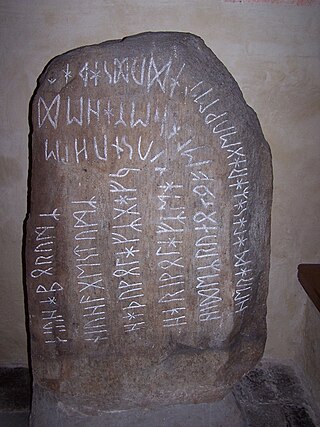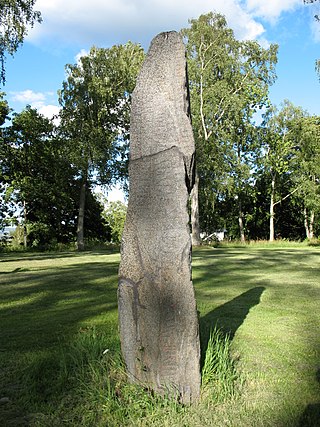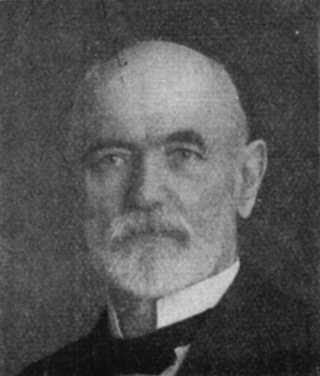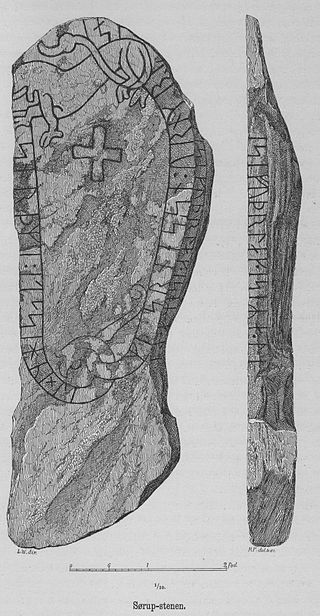
Swedish is a North Germanic language spoken predominantly in Sweden and in parts of Finland. It has at least 10 million native speakers, the fourth most spoken Germanic language and the first among any other of its type in the Nordic countries overall.

The Kensington Runestone is a slab of greywacke stone covered in runes that was discovered in central Minnesota in 1898. Olof Öhman, a Swedish immigrant, reported that he unearthed it from a field in the largely rural township of Solem in Douglas County. It was later named after the nearest settlement, Kensington.

A rune is a letter in a set of related alphabets known as runic alphabets native to the Germanic peoples. Runes were used to write Germanic languages before they adopted the Latin alphabet, and for specialised purposes thereafter. In addition to representing a sound value, runes can be used to represent the concepts after which they are named (ideographs). Scholars refer to instances of the latter as Begriffsrunen. The Scandinavian variants are also known as futhark or fuþark ; the Anglo-Saxon variant is futhorc or fuþorc.
The 1922-23 season in Swedish football, starting March 1922 and ending July 1923:
The 1924–25 season in Swedish football, starting August 1924 and ending July 1925:
The 1925–26 season in Swedish football, starting August 1925 and ending July 1926:
The 1926-27 season in Swedish football, starting August 1926 and ending July 1927:

The Stentoften Runestone, listed in the Rundata catalog as DR 357, is a runestone which contains a curse in Proto-Norse that was discovered in Stentoften, Blekinge, Sweden.
A runic inscription is an inscription made in one of the various runic alphabets. They generally contained practical information or memorials instead of magic or mythic stories. The body of runic inscriptions falls into the three categories of Elder Futhark, Anglo-Frisian Futhorc and Younger Futhark.

The Danish language developed during the Middle Ages out of Old East Norse, the common predecessor of Danish and Swedish. It was a late form of common Old Norse. The Danish philologist Johannes Brøndum-Nielsen divided the history of Danish into "Old Danish" from 800 AD to 1525 and "Modern Danish" from 1525 and onwards. He subdivided Old Danish into "Runic Danish" (800–1100), Early Middle Danish (1100–1350) and Late Middle Danish (1350–1525).

The Saleby Runestone, designated as Vg 67 in the Rundata catalog, was originally located in Saleby, Västra Götaland County, Sweden, which is in the historic province of Västergötland, and is one of the few runestones that is raised in memory of a woman.
The Greece runestones are about 30 runestones containing information related to voyages made by Norsemen to the Byzantine Empire. They were made during the Viking Age until about 1100 and were engraved in the Old Norse language with Scandinavian runes. All the stones have been found in modern-day Sweden, the majority in Uppland and Södermanland. Most were inscribed in memory of members of the Varangian Guard who never returned home, but a few inscriptions mention men who returned with wealth, and a boulder in Ed was engraved on the orders of a former officer of the Guard.
Erik Moltke was a Danish runologist, writer, and editor. Through his leadership, the Runologist Section of the National Museum of Denmark became a world centre for the scientific study of runology.

The medieval runes, or the futhork, was a Scandinavian runic alphabet that evolved from the Younger Futhark after the introduction of stung runes at the end of the Viking Age. These stung runes were regular runes with the addition of either a dot diacritic or bar diacritic to indicate that the rune stood for one of its secondary sounds. The medieval futhork was fully formed in the early 13th century. Due to the expansion of its character inventory, it was essentially possible to have each character in an inscription correspond to only one phoneme, something which was virtually impossible in Younger Futhark with its small inventory of 16 runes.

The Sønder Kirkeby Runestone, listed as runic inscription DR 220 in the Rundata catalog, is a Viking Age memorial runestone that was discovered in Sønder Kirkeby, which is located about 5 kilometers east of Nykøbing Falster, Denmark.

Raymond Ian Page was a British historian of Anglo-Saxon England and the Viking Age. As a renowned runologist, he specialised in the study of Anglo-Saxon runes.

The Prince Eugen Medal is a medal conferred by the King of Sweden for "outstanding artistic achievement".

Erik Brate was a Swedish linguist and runologist.

The Sørup runestone is a runestone from Sørup close by Svendborg on southern Funen in Denmark. The stone has a relatively long and very debated runic inscription, which has been seen as an unsolved cipher or pure nonsensical, but also has been suggested to be written in Basque.
Elisabeth (Lis) Jacobsen, née Rubin, was a Danish philologist, archaeologist and writer. She is remembered first and foremost for her research and publications on the history of the Danish language but she was also an expert runologist who published a comprehensive analysis of all known runic inscriptions in Denmark. From 1911, Jacobsen played a major role in all fields of research related to the Danish language.